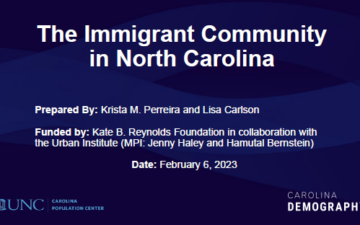NC in Focus: Grandparents Living with their Grandchildren

There are currently over 210,000 grandparents living with their own grandchildren (under age 18) in North Carolina, according to the 2012-16 American Community Survey 5-year Estimates. This is approximately 3.5% of the adult population 30 years and older. Of those living with their grandchildren, slightly less than half of grandparents (46%) were primary caregivers, meaning they had financial responsibility for the basic needs of grandchildren in their household. For many individuals, this is a long-term role. Forty-three percent of grandparents with caregiver responsibilities in NC had been providing support for five years or more, and over 80% had been responsible for their grandchild or grandchildren for at least one year.
There is a nearly even split among grandparents living with their grandchildren by employment status: 49.6% are currently working and 50.4% are not in the labor force. A majority of grandparents currently working also had caregiver responsibilities (54%), while just 39% of those out of the labor force were financially responsible for their grandchildren.
Overall, there are over 175,000 grandchildren currently living with their grandparents; 58% of them were being taken care of by their grandparents. In the majority of cases (62%), there was a parent present in the household, as well.
Across counties, the percentage of grandparents living with their grandchildren ranges from under 2% to over 7%. Counties with the largest shares of grandparents living with their grandchildren tended to cluster in the Sandhills and northeastern regions of the state. The top five counties were:
Meanwhile, many of the counties with the smallest shares of grandparents living with their grandchildren were located in the western and north-central portions of the state. These included:
In 46 counties, half or more of the grandparents living with their grandchildren acted as caregivers. Nearly everywhere, the majority of them were grandmothers, except in three counties:
Additionally, in nearly three-fourths of counties, grandparents who lived with their grandchildren and were in the labor force were also providing financial support.
For a deeper dive, explore this interactive county map below.
Note: Some percentages may not sum to 100 due to rounding errors.
Need help understanding population change and its impacts on your community or business? Carolina Demography offers demographic research tailored to your needs.
Contact us today for a free initial consultation.
Contact UsCategories: Carolina Demographics

The Center for Women’s Health Research (CWHR) at the University of North Carolina School of Medicine released the 12th edition of our North Carolina Women’s Health Report Card on May 9, 2022. This document is a progress report on the…

Dr. Krista Perreira is a health economist who studies disparities in health, education, and economic well-being. In collaboration with the Urban Institute, she recently co-led a study funded by the Kate B. Reynolds Foundation to study barriers to access to…

Our material helped the NC Local News Lab Fund better understand and then prioritize their funding to better serve existing and future grant recipients in North Carolina. The North Carolina Local News Lab Fund was established in 2017 to strengthen…
Your support is critical to our mission of measuring, understanding, and predicting population change and its impact. Donate to Carolina Demography today.